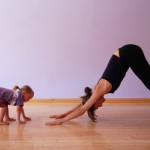 By Kristen McCarthy
By Kristen McCarthyPractice yoga balancing postures for kids and you can fly like an eagle or be as still as a tree. Yoga for kids expands your imagination and tests your inner focus. Play with eagle pose for kids and imagine that you have long feathers and massive wings. You perch high up on a tree and watch the world below you. What do you see? Or play with dancer yoga pose and become a beautiful ballerina with a tutu and crown. You twirl and bow on stage in front of the bright lights.
Can you hear the audience applaud?
Play with tree yoga posture to become an ancient tree in a redwood forest. Your roots reach deep into the earth and your branches touch the sun. You provide a home to thousands of animals, insects, and birds.
Can you feel the earth below you?
Yoga balancing postures for kids:
Eagle, dancer, and tree yoga postures have three things in common:
1. These three positions are balancing postures
2. They begin standing in mountain pose
3. Additionally, they require concentration
To try any three of these balancing yoga poses, come to the front of yoga mat, and stand with your feet together in mountain pose.
Place your hands at your heart center with palms touching.
Find spot to gaze at in front of you. It could be the horizon outside of the window. It could be a picture hanging on the wall. Or, it could be a dirty fingerprint by the light switch that mom and dad haven’t noticed yet.
Now you’re ready to test out your balance with these three Hatha Yoga poses:
Eagle yoga posture: Imagine what it feels like to be inside the body of an eagle. Steady your breath and feel your right foot firm on the ground. INHALE and bend your knees, EXHALE and spread your arms out to your sides like wings. You are the soaring eagle. As you INHALE bring your hands to your waist, cross your left leg over your right leg. Your left toes can touch the floor or wrap around your right leg. You are the perched eagle. Hold for three breaths and then repeat on the opposite side.
Dancer yoga posture: Imagine that you’re a ballet dancer. Steady your breath and feel your right foot firm on the ground. INHALE and lift your left heel towards your bum. EXHALE, and grab your foot and feel it press into your hand. INHALE and stretch your left arm straight into the air and lengthen your torso. EXHALE as you lean your body forward and allow your left leg to rise into the air. Breathe here and imagine you are on stage. Repeat on the opposite side.
Dancer yoga posture: Imagine that you’re a ballet dancer. Steady your breath and feel your right foot firm on the ground. INHALE and lift your left heel towards your bum. EXHALE, and grab your foot and feel it press into your hand. INHALE and stretch your left arm straight into the air and lengthen your torso. EXHALE as you lean your body forward and allow your left leg to rise into the air. Breathe here and imagine you are on stage. Repeat on the opposite side.
Some Thoughts to Consider
How far can the eagle see?
Can you hear your applause as a dancer?
How old is the ancient tree?
When you steady your mind and breath then kids yoga will allow your imagination to soar.
Kids yoga benefits:
When you practice kids balancing postures you are doing more than activating your imagination.
In eagle yoga posture you: strengthen your legs and build your inner sense of determination and will.
During dancer yoga posture: you stretch your quadriceps, lengthen your spine, and challenge your inner focus.
While practicing tree yoga posture you: open your hips, and strengthen your ankles, and ground your body and mind.
So keep practicing yoga for kids and you’ll be able to bend metal with your mind in no-time (well, maybe not, but you’ll be able to do lots of cool stuff).
Namaste Super Yogi
Kristen McCarthy is a Yoga Alliance certified Hatha Yoga teacher.
Click here to see our online Yoga Nidra teacher training course.
Are you an experienced teacher looking for YACEP credits or continuing education?
Subscribe to Our Newsletter for Special Discounts and New Products
Related Resources
52 Essential Principles of Yoga Philosophy to Deepen your Practice
by Rina Jakubowicz.
A Relaxing Way to De-stress, Re-energize, and Find Balance
by: Gail Boorstein Grossman.
YOGA: THE PATH TO HOLISTIC HEALTH
by B.K.S. Iyengar
TEACHING YOGA: Essential Foundations and Techniques
By Mark Stephens
To see our selection of Yoga teacher training and continuing education courses, please visit the following link.
https://aurawellnesscenter.com/store/
Three Yoga Balancing Postures – You May Not Have Tried
By Kathryn Boland
Do you teach balancing postures in your classes? Do they tend to be the same Tree Pose (Vrksasana) and Airplane Pose (Dekasana)? These poses offer multiple benefits, and more so when students can achieve relatively consistent stability within them. There’s nothing wrong with including them in many of your classes! Yet, at some point, your students would enjoy and benefit from experiencing new balancing postures.
Underlying this, many yoga practitioners seem to have an intriguing dread of, yet fascination with, balancing postures. Cue them, and see some students look at you wide-eyed – like a deer in headlights, others flash you a nervous grin, others seeming determined that the poses will not defeat them. Twenty seconds later, in the pose, those same students have incredible focus – most often calm, full of rhythmic breath.
Cuing Ideas
You might cue them out of the balance into another pose, and they hold on, trying to find their best balance. Offering balance poses that they might not have ever experienced, or not have experienced in some time, can enhance this process of true yoga – noticing a reaction to difficulty, and shifting that to committed yet calm focus. Please read on for three such balance poses. Om Shanti!
*Note: The following are suggestions for how to cue your students into and through the poses. After holding the right side for five to ten breaths, cue students to release the leg raised in the balance to the floor. Then guide them into and through the same on the other side (or do so later, as part of a sequence of poses on an opposite side). Switch all of this to the left side first, if necessary. Remember, however, that twists – part of two of the following poses – are best done to the right first.
Twisted Standing Single Leg Balance
This pose adds a twist, literally, to the classic Standing Single Leg Balance pose. Even more focus, strong drishti (gaze), and calm strength is needed.
1. Raise the right leg until it is extending directly out of the right hip, or as high as you can without significantly leaning back. A modification is a bent knee, instead of straight leg. That’s an option if you’re finding the straight leg version inaccessible, or just more of a challenge than is desirable for you today.
2. To further stabilize the pose, start with Mountain Pose feet qualities on the standing leg – grounded through the big toe and lifted through the inner arch (instep). Engage the core and all parts of the legs, but especially the hamstrings. Hold a steady drishti on a non-moving spot ahead.
3. From here, begin the twist. With the bent knee version, hold the outer thigh with the left hand (or place the back of the hand to the thigh, so long as that is sufficiently stable, to get more leverage for the twist). With the extended knee/straight leg version, reach for the outer edge of the flying foot. Reach backwards with the right hand, with the pinky edge down and an open palm.
4. Slowly and steadily look backwards. If that starts to disturb balance too much, look to the side. Find more length through the spine with breaths in, and just a bit more twist with breaths out – the left lung coming forward, the right lung back. Adding on with every breath, a longer and deeper twist grows.
Side Bending Tree Pose
This variation on tree pose is certainly challenging, but there are ways to modify it so that it can be accessible for mostly everyone. Besides the benefits of Tree Pose, a long side stretch might also occur.
1. Come into Tree Pose – your right foot “kickstanding” (toes grounded and heel up), on the calf or the thigh – anywhere but the left knee! Take hands to Anjali Mudra (prayer position) at heart center, or raise arms to the sky (“sprouting branches”) in a narrow “V” shape.
2. Further stabilize the pose through finding a steady gaze on a non-moving point of focus, pushing the right foot into the left leg and vice-versa. Breathe fully and deeply, ensuring chin is parallel with the floor to remove or lessen any obstruction to breath at the throat.
3. Begin the sidebend by taking a “steeple” mudra, taking right hand to right hip and keeping the left arm raised, or taking another desired position with the arms and hands. Begin to slowly, gently sidebend towards the right.
4. If it’s too challenging to balance with the sidebend, it’s fine to take the “kickstand” variation as described – because it’s not standing on two flat feet, it’s still offering the challenges and benefits of a balancing posture!
Revolved Half-Moon Pose
This is another rather difficult balancing posture, but with prop usage it can be far more accessible. If all else fails, many of the same benefits come from a Runner’s Twist Pose. It offers enhancement of so much – flexibility, core strength, balancing, focus, and breath control.
1) Set up Half Moon Pose (Ardha Chandrasana) – a good starting place is Trikonasana. From there, put weight on your left (front) foot and let your back (right) leg raise in the air (ideally directly out of the hip). As soon as the right foot leaves your mat, give it a hard flex to help the leg stay raised.
2) Remember your Mountain Pose feet (as described), and lean back behind your heart. Keep your top hip dropping, yet the bottom lung facing up towards that hip. Can you breathe easy here, even in one of the most difficult balancing postures?
3) The most difficult part of this balancing postures is revolving! Have your left hand ready to take your block over to the right side. Start to square off your hips and bring your right arm (from reaching up to the sky) down to your block on the right side (the left hand passing it over). Slowly, carefully raise your left arm to the sky (peeling up or swinging back, then up). Slowly, carefully look up at the left hand. If that’s too destabilizing, look towards the left side.
4) Engage the core, and feel the flying inner thigh rise to the sky. In Mountain Pose energetics, feel the inner thighs hug a bit in towards each other, yet the outer thighs wrap away from each other. Breathe! This is undeniably difficult, but it’s temporary! If the pose is truly inaccessible at this time, you’ll get more out of a Runner’s Twist Pose (as well as avoid a potentially dangerous fall) – so let the ball of the right foot land, everything else staying the same (the same pose, just on a lower level and both feet on the ground).
© Copyright – Aura Wellness Center – Publications Division

I loved this! Thank you for sharing these wonderful insights.I appreciated this useful article.